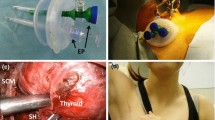Abstract
Background
The arguments for applying minimally invasive techniques are, besides cosmetic results, reduced access trauma and less postoperative pain. In thyroid surgery, cosmetic aspects are gaining importance. Whether minimally invasive endoscopic thyroid surgery is less painful has not been shown yet.
Method
In this study, we analyse the outcome of 246 patients who underwent cervical endoscopic video-assisted thyroid surgery (CEViTS) regarding the surgery itself, their postoperative pain and satisfaction with the procedure.
Results
CEViTS is routinely performed in our hospital. In this study, no postoperative bleedings that would have made a reoperation necessary occurred. All lobectomies could be completed endoscopically. In two cases, conversions (enlargement of the 5-mm incision to 25 mm) were necessary. Transient nerve palsy was registered in three patients (1.22%). One patient (0.41%) had a permanent palsy of the recurrent laryngeal nerve. In comparison to open surgery (n = 173 patients), the 246 CEViTS patients had a significantly lower pain level (p = 0.047).
Conclusions
Cervical endoscopic video-assisted thyroid surgery (CEViTS) can be considered a safe, less traumatizing and useful minimally invasive procedure in endoscopic thyroid surgery.







Similar content being viewed by others
References
Witzel K, von Rahden BH, Stein HJ (2009) The effect of ultrasound dissection in thyroid surgery. Eur Surg Res 43:241–244
Dralle H, Sekulla C, Haerting J, Timmermann W, Neumann HJ, Kruse E, Grond S, Muhlig HP, Richter C, Voss J, Thomusch O, Lippert H, Gastinger I, Brauckhoff M, Gimm O (2004) Risk factors of paralysis and functional outcome after recurrent laryngeal nerve monitoring in thyroid surgery. Surgery 136(6):1310–1322
Sessa L, Lombardi CP, De Crea C, Raffaelli M, Bellantone R (2017) Video-assisted endocrine neck surgery: state of the art. Updat Surg 69(2):199–204. doi:10.1007/s13304-017-0467-3
Miccoli P, Rago R, Massi M, Panicucci E, Metelli MR, Berti P, Minuto MN (2010) Standard versus video-assisted thyroidectomy: objective postoperative pain evaluation. Surg Endosc 24:2415–2417
Kang JB, Kim EY, Park YL, Park CH, Yun JS (2017) A comparison of postoperative pain after conventional open thyroidectomy and single-incision, gasless, endoscopic transaxillary thyroidectomy: a single institute prospective study. Ann Surg Treat Res 92(1):9–14. doi:10.4174/astr.2017.92.1.9. Epub 2016 Dec 30
Witzel K, Benhidjeb T, Stark M, Draf W (2008) Stand und Stellenwert der video-assistierten Schilddrüsenchirurgie. Laryngo-Rhino-Otologie, Laryngorhinootologie 87(9):623–627
Miccoli P, Berti P, Frustaci GL, Ambrosini CE, Materazzi G (2006) Video-assisted thyroidectomy: indications and results. Langenbecks Arch Surg 391(2):68–71
Witzel K (2007) The axillary access in unilateral thyroid resection. Langenbecks Arch Surg 392(5):617–621
Bärlehner E, Benhidjeb T (2008) Cervical scarless endoscopic thyroidectomy: axillo-bilateral-breast approach (ABBA). Surg Endosc 22(1):154–157. Epub 2007 Apr 13
Witzel K, von Rahden BH, Kaminski C, Stein HJ (2008) The transoral access in endoscopic thyroid resection. Surg Endosc 22(8):1871–1875
Anuwong A (2016) Transoral endoscopic thyroidectomy vestibular approach: a series of the first 60 human cases. World J Surg 40(3):491–497
Messenbaeck FG (2004) Endoskopische Schilddruesenchirurgie [endoscopic thyroid surgery]. Chir Prax 63:647–657
Palazzo FF, Sebag F, Henry JF (2006) Endocrine surgical technique: endoscopic thyroidectomy via the lateral approach. Surg Endosc 20(2):339–342
Shimizu K, Tanaka S (2003) Asian perspective on endoscopic thyroidectomy – a review of 193 cases. Asian J Surg 26(2):92–100
Cai C, Huang Y, Zhang T, Chai L, Wang G, Shi L, Wiegand S, Güldner C, Günzel T, Wilhelm T (2015) Anatomical study of surgical approaches for minimally invasive transoral thyroidectomy: eMIT and TOPP. Minim Invasive Ther Allied Technol 24(6):340–344. doi:10.3109/13645706.2015.1034728. Epub 2015 Apr 8
Witzel K, Benhidjeb T (2009) Monitoring of the recurrent laryngeal nerve in totally endoscopic thyroid surgery. Eur Surg Res 43(2):72–76
Witzel K (2009) Hybrid technologies for determining optimal approach in endoscopic thyroidectomy. Surg Endosc 23:456
Benhidjeb T, Witzel K, Stark M, Mann O (2011) Transoral thyroid and parathyroid surgery: still experimental! Surg Endosc 25(7):2411–2413
Benhidjeb T, Witzel K, Bärlehner E et al (2007) The natural orifice surgery concept. Vision and rationale for a paradigm shift. Chirurg 78:537–542
Wilhelm T, Metzig A (2010) Video. Endoscopic minimally invasive thyroidectomy: first clinical experience. Surg Endosc 24:1757–1758
Wilhelm T, Metzig A (2011) Endoscopic minimally invasive thyroidectomy (eMIT): a prospective proof-of-concept study in humans. World J Surg 35:543–551
Karakas E, Steinfeldt T, Gockel A et al (2014) Transoral parathyroid surgery–a new alternative or nonsense? Langenbecks Arch Surg 399:741–745
Neugebauer EA, Becker M, Buess GF et al (2010) EAES recommendations on methodology of innovation management in endoscopic surgery. Surg Endosc 24:1594–1615
Benhidjeb T, Witzel K, Burghardt J et al (2010) Endoscopic minimally invasive thyroidectomy: ethical and patients’ safety considerations on the first clinical experience of an innovative approach. Surg Endosc. doi:10.1007/s00464-010-1290-9
Witzel K, Hellinger A, Kaminski C et al (2016) Endoscopic thyroidectomy: the transoral approach. Gland Surg 5:336–341
Author information
Authors and Affiliations
Corresponding author
Ethics declarations
Disclosure
Franz Messenbaeck, Michael Weitzendorfer, Cornelia Kaminski and Kai Witzel have no conflicts of interest or financial ties to disclose. All authors do disclose all institutional or corporate/commercial relationships.
Electronic supplementary material
Below is the link to the electronic supplementary material.
Supplementary material 1 (MP4 256444 kb)
Rights and permissions
About this article
Cite this article
Messenbaeck, F.G., Weitzendorfer, M., Kaminski, C. et al. Minimally invasive endoscopic thyroid surgery using a collar access: experience in 246 cases with the CEViTS technique. Surg Endosc 32, 1607–1612 (2018). https://doi.org/10.1007/s00464-017-5783-7
Received:
Accepted:
Published:
Issue Date:
DOI: https://doi.org/10.1007/s00464-017-5783-7




